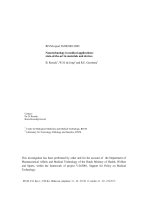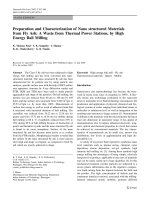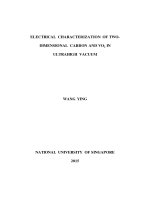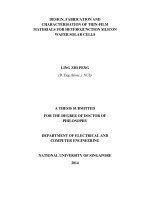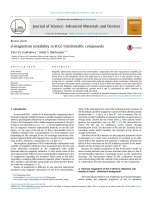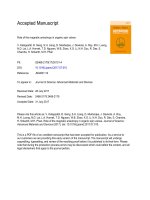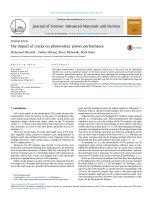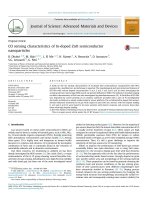electrical characterization of organic electronic materials and devices pdf
Bạn đang xem bản rút gọn của tài liệu. Xem và tải ngay bản đầy đủ của tài liệu tại đây (1.66 MB, 318 trang )
www.TechnicalBooksPdf.com
Electrical Characterization
of Organic Electronic
Materials and Devices
Peter Stallinga
Center for Electronics, Optoelectronics and
Telecommunications
University of The Algarve
A John Wiley and Sons, Ltd., Publication
www.TechnicalBooksPdf.com
www.TechnicalBooksPdf.com
Electrical Characterization
of Organic Electronic
Materials and Devices
www.TechnicalBooksPdf.com
www.TechnicalBooksPdf.com
Electrical Characterization
of Organic Electronic
Materials and Devices
Peter Stallinga
Center for Electronics, Optoelectronics and
Telecommunications
University of The Algarve
A John Wiley and Sons, Ltd., Publication
www.TechnicalBooksPdf.com
This edition first published 2009
2009 John Wiley & Sons Ltd
Registered office
John Wiley & Sons Ltd, The Atrium, Southern Gate, Chichester, West Sussex, PO19 8SQ, United Kingdom
For details of our global editorial offices, for customer services and for information about how to apply for
permission to reuse the copyright material in this book please see our website at www.wiley.com.
The right of the author to be identified as the author of this work has been asserted in accordance with the
Copyright, Designs and Patents Act 1988.
All rights reserved. No part of this publication may be reproduced, stored in a retrieval system, or
transmitted, in any form or by any means, electronic, mechanical, photocopying, recording or otherwise,
except as permitted by the UK Copyright, Designs and Patents Act 1988, without the prior permission of
the publisher.
Wiley also publishes its books in a variety of electronic formats. Some content that appears in print may
not be available in electronic books.
Designations used by companies to distinguish their products are often claimed as trademarks. All brand
names and product names used in this book are trade names, service marks, trademarks or registered
trademarks of their respective owners. The publisher is not associated with any product or vendor
mentioned in this book. This publication is designed to provide accurate and authoritative information in
regard to the subject matter covered. It is sold on the understanding that the publisher is not engaged in
rendering professional services. If professional advice or other expert assistance is required, the services of a
competent professional should be sought.
The publisher and the author make no representations or warranties with respect to the accuracy or
completeness of the contents of this work and specifically disclaim all warranties, including without
limitation any implied warranties of fitness for a particular purpose. This work is sold with the
understanding that the publisher is not engaged in rendering professional services. The advice and strategies
contained herein may not be suitable for every situation. In view of ongoing research, equipment
modifications, changes in governmental regulations, and the constant flow of information relating to the
use of experimental reagents, equipment, and devices, the reader is urged to review and evaluate the
information provided in the package insert or instructions for each chemical, piece of equipment, reagent,
or device for, among other things, any changes in the instructions or indication of usage and for added
warnings and precautions. The fact that an organization or Website is referred to in this work as a citation
and/or a potential source of further information does not mean that the author or the publisher endorses
the information the organization or Website may provide or recommendations it may make. Further,
readers should be aware that Internet Websites listed in this work may have changed or disappeared
between when this work was written and when it is read. No warranty may be created or extended by any
promotional statements for this work. Neither the publisher nor the author shall be liable for any damages
arising herefrom.
Library of Congress Cataloging-in-Publication Data
Stallinga, Peter, 1966Electrical characterization of organic electronic materials and devices / Peter Stallinga.
p. cm.
Includes bibliographical references and index.
ISBN 978-0-470-75009-4 (cloth : alk. paper) 1. Electronics–Materials. 2. Organic
electronics. 3. Organic semiconductors. 4. Electronic apparatus and appliances–Materials.
I. Title.
TK7871.S73 2009
621.381–dc22
2009028761
A catalogue record for this book is available from the British Library.
ISBN: 978-0-470-75009-4 (Cloth)
Typeset in 10.5/13 Sabon by Laserwords Private Limited, Chennai, India
Printed and bound in Great Britain by TJ International, Padstow, Cornwall
www.TechnicalBooksPdf.com
Contents
Preface
ix
1 General concepts
1.1
Introduction
1.2
Conduction mechanism
1.3
Chemistry and the energy diagram
1.3.1 Energy diagram of crystalline materials
1.3.2 Energy diagram of amorphous materials
1.4
Disordered materials and the Meyer–Neldel Rule
1.5
Devices
1.5.1 Resistor
1.5.2 Schottky diode
1.5.3 MIS diode and MIS tunnel diode
1.5.4 Thin-film transistor
1.6
Optoelectronics/photovoltaics
1
1
6
10
17
24
27
28
29
31
35
35
38
2 Two-terminal devices: DC current
2.1
Conductance
2.1.1 Ohmic conduction
2.1.2 Poole–Frenkel
2.1.3 Tunneling
2.1.4 Space-charge-limited current
2.1.5 Granular materials; grain boundaries
2.2
DC current of a Schottky barrier
2.2.1 High-current regime
2.2.2 Displacement current
45
45
48
48
52
53
57
58
60
60
www.TechnicalBooksPdf.com
vi
CONTENTS
2.3
DC measurements
2.3.1 van der Pauw
2.3.2 Hall effect
3 Two-terminal devices: Admittance spectroscopy
3.1
Admittance spectroscopy
3.1.1 Low-frequency RCL bridge
3.1.2 DC admittance
3.2
Geometrical capacitance
3.3
Equivalent circuits
3.4
Resistor; SCLC
3.5
Schottky diodes
3.5.1 Schottky diode; nonuniform doping
3.5.2 Schottky diode; adding an abundant deep
acceptor level
3.5.3 Schottky diode; minority levels
3.5.4 Schottky barrier; temperature dependence
3.6
MIS diodes
3.6.1 MIS of doped semiconductors
3.6.2 MIS with interface states
3.6.3 MIS of low-mobility semiconductors
3.7
MIS tunnel diode
3.8
Noise measurements
62
62
64
65
65
71
73
74
74
79
80
84
84
88
90
91
92
99
108
115
117
4 Two-terminal devices: Transient techniques
4.1
Kinetics: Emission and capture of carriers
4.1.1 Emission and capture in organic materials
4.2
Current transient spectroscopy
4.2.1 Example of an emission experiment
4.2.2 Example of a capture experiment
4.3
Thermally stimulated current
4.4
Capacitance transient spectroscopy
4.4.1 Case study: Example of a capacitance
transient measurement
4.5
Deep-level transient spectroscopy
4.6
Q-DLTS
119
120
125
126
126
130
133
138
5 Time-of-flight
5.1
Introduction
5.2
Drift transient
5.3
Diffusive transient
153
153
155
162
www.TechnicalBooksPdf.com
145
148
151
vii
CONTENTS
5.4
5.5
5.6
5.7
5.8
Violating Einstein’s Relation
Multi-trap-and-release
Anomalous transients
High current (space charge) transients
Summary of the ToF technique
6 Thin-film transistors
6.1
Field-effect transistors
6.2
MOS-FET
6.2.1 MOS-FET threshold voltage
6.2.2 MOS-FET current
6.2.3 Exact solution
6.2.4 MOS-FET subthreshold current and
subthreshold swing
6.3
Introducing TFTs
6.4
Basic model
6.4.1 Threshold voltage and subthreshold current
6.5
Justification for the two-dimensional approach
6.6
Ambipolar materials and devices
6.7
Contact effects and other simple nonidealities
6.7.1 Insulator leakage
6.7.2 Contact resistance
6.7.3 Contact barriers
6.7.4 Grain boundaries
6.7.5 Parallel conductance
6.8
Metallic contacts in TFTs
6.9
Normally-on TFTs
6.9.1 Narrow gap semiconductors
6.9.2 Thick TFTs
6.9.3 Doped semiconductors and inversion-channel
TFT
6.9.4 Metal–insulator–metal TFT
6.10 Effects of traps
6.10.1 Traps and threshold voltage
6.10.2 Traps and output curves
6.10.3 Traps and transfer curves
6.10.4 Traps and ‘stressing’ (threshold-voltage shift)
6.10.5 Traps and transients
6.10.6 The origin of the traps
6.10.7 Summary of the effects of traps on the TFT
characteristics
www.TechnicalBooksPdf.com
168
169
174
180
184
189
189
191
194
196
196
199
200
202
206
208
211
215
217
221
223
228
229
230
236
239
242
244
246
248
249
250
253
264
267
269
271
viii
CONTENTS
6.11
6.12
6.13
Admittance spectroscopy for the determination of the
mobility in TFTs
Summary of TFT measurements
Diffusion transistor
272
275
275
Appendix A Derivation of Equations (2.21), (2.25), (6.95)
and (6.101)
281
Bibliography
285
Index
299
www.TechnicalBooksPdf.com
Preface
This book is the summary of more than a decade of investigation of
organic electronic materials and devices carried out at the Optoelectronics Laboratory at the University of The Algarve. It is in no way a
summary of the literature, though an extensive selection of references is
included. (It should be made clear from the beginning that by mentioning
a paper in the literature does not imply that I approve of its contents,
agree with its conclusions, or even recommend its reading, nor that I
fully understood its message; it only serves the purpose of mentioning
works on the subject and gives a possible starting point for interested
readers. Some of the papers, especially in the introductory parts, I have
to admit, I did not even read thoroughly myself; the list of citations at
the end is thus a mixture of references and bibliography.)
Every time a concept of electrical behavior came up, I tried to understand it by making calculations, or, more often, by making simulations,
until the behavior was in-line with how I understood things to work.
Often my understanding of things was wrong and it had to be changed
to be in-line with simulation and results in our laboratory and results
presented in the literature. Even while writing this book, I changed my
thinking substantially in some places, showing that the learning curve
is infinite. It also shows that, probably, this book is still full of errors
and misconceptions. It is to be considered, still, an unfinished work. It
should therefore not be seen as an absolute book, believing everything
without questioning. It should rather be seen as a work to stimulate
thinking and to help the scientist on the way with proper tools.
I also suffer from the constant need to not only understand things, but
to also make the description as simple as possible, to strip away all the
www.TechnicalBooksPdf.com
x
PREFACE
unneeded embellishments, and to reduce it to its important core. While
obviously missing out on some descriptive power of the ideas, the gain
of hopefully making it possible for many more people to understand
compensates enough. In my opinion, it is not the task of a scientist to
understand nature, it is rather to model it and explain it to others so
that they can understand it and further build on it. If not, all gained
knowledge will be lost at the end of the career of the scientist.
Never, in any case, did I assume things to be correct in the literature
and just conveniently reference them away when encountering similar
behavior in our materials and devices. A multitude of papers exist that
are far beyond my grasp. After some failed attempts, I ignored these
papers (some of them are still mentioned in this book, so that you can
take a look yourself). The most remarkable result of this approach is
probably the description, from the origin, of the thin-film transistor
with, as final end-product, a predicted and implemented transistor based
on a metal as the active layer. Looking back at it, I now consider it
something completely trivial and expected. Most people will probably
agree that it is trivial. However, the same reasoning also led to the
accurate description of the contact effects, something that conflicts with
a large number of papers in the literature.
It always gave me immense pleasure to work on the subject and to
realize that, after all, nature is a fascinating complex world, but when
persisting, even for a humble and ignorant human being, it is possible
to understand some things. Then, the beauty lies in its simplicity. As
a single starting point, I used the idea ‘Think as an electron’; when
thinking as an electron, the rest will follow. In case of doubt it is best to
ask ‘What would I do if I were an electron?’ This is funny, in a way, but
in many cases very helpful.
This work, of course, would not have come about without the help
of other people. Most important in this respect is Henrique Gomes, my
colleague at the Optoelectronics Laboratory. Sometimes, by just saying
a couple of phrases, he pointed the way to a better understanding of
things, things that would sometimes take me months or even years
to figure out in all their myriad implications. Likewise, the comments
and observation of Martin Taylor have been extremely helpful. The
discussions with Adriano Benvenho were always a good inspiration
for a lot of the work. I also thank him for proofreading this book. My
students Nelson Pimenta and Jos´e Almada are thanked for implementing
the transistor admittance spectroscopy system described in Chapter 6.
www.TechnicalBooksPdf.com
xi
PREFACE
I hope this text is helpful to you, the reader, too. After all, that is the
aim of this work.
Peter Stallinga
Faro, Portugal
February 2009
www.TechnicalBooksPdf.com
www.TechnicalBooksPdf.com
1
General Concepts
1.1 INTRODUCTION
This book describes the electronic measurements of materials and devices
based on amorphous materials, with an emphasis on organic electronic
materials. The distinction of what is exactly an organic material is
rather vague, but generally speaking it is all those materials that contain
carbon. This area is rather vast (see for instance the book on organic
chemistry by Wade [1]). For this work the ones that are important are
those that are electrically active, basically organic semiconductors. That
organic materials can be semiconductors is nothing new. Wallace has
shown already in 1947 that graphite is a semiconductor [2]. (Curiously
enough, graphene, a monolayer of graphite, is again a hot-topic material
[3].) Recently, though, a new wave of research in organic electronics has
got under way, powered by the need for cheap electronic devices or other
devices that cannot be made by conventional, ‘classic’ semiconductors
and helped by the accidental discovery that organic materials can be as
conductive as metals and further stimulated by the continuing advances
in technology of fabrication of materials and devices.
Two decades and a Nobel Prize after the start of this new wave of
organic electronic research, commercial devices are a reality [4]; manufacturers advertise that their products have light emitting diodes based
on organic materials (OLEDs), to name but an example. Like in most
technological advances, the understanding of the devices lags behind.
There are many issues yet to be solved. The most important may be
Electrical Characterization of Organic Electronic Materials and Devices Peter Stallinga
2009 John Wiley & Sons, Ltd
www.TechnicalBooksPdf.com
2
GENERAL CONCEPTS
the electronic processes governing the conduction of charge. On the one
hand there exists the idea that the conduction consists of hopping from
one molecular orbit to the other. Such hopping models centered around
the molecular aspects obviously find many followers among chemists.
Conduction is then considered a perturbation to the system. On the
other hand there exists the solid-state-physicists approach of treating
the materials like any semiconducting material and describing the electronic states of the material in the classical conduction and valence
bands. The molecular properties are then treated as a perturbation. The
answer will lie probably somewhere in between. However, electronic
devices can only be made from semiconductor (conducting) materials.
In view of this it is most obvious that existing working devices are best
described by classic semiconductor theory, at least as a starting point,
and changes should only be introduced into the theory when needed.
However, organic electronic materials research evolved from chemistry
and the publications by chemists far outnumber the publications of semiconductor physicists. Many papers describe the problems encountered
when fabricating the materials, whereas the electronic parameters, such
as band gap, effective mass, or electron affinity are difficult to encounter.
The electrical characteristics of the resulting materials often serve as a
by-product of the chemical research, without even trying to understand
or describe them well. As an example, often the mobility is presented as
a parameter to describe the quality, the ‘success’, of the new proposed
production route, or to compare one material with another [5]. Review
articles often present tables with best mobilities, for instance to show
the evolution over time [6–8]. However, just presenting the mobility
value without specifying the conditions is as meaningless as presenting
a current without specifying the applied bias. In view of this, it is often
difficult to compare the results presented by different research institutes.
The current book is an attempt to explain the mechanisms involved in
the electrical characteristics of organic materials and the measurement
techniques used to determine the relevant parameters. The starting point
is the theory of the ‘old school’ of semiconductor devices which is very
well described by the classical book of Sze [9], a book which will be
cited many times throughout this work. The reader is advised to obtain
a copy of this book. More recent books include novel devices, such as
thin-film transistors (TFTs), for example the book by Shur [10]. There
also exist good books about the measurement techniques in general. The
book by Blood and Orton may serve as an example [11]. The current
work describes how and when the ideas of these books, written for
www.TechnicalBooksPdf.com
3
INTRODUCTION
classical semiconductors, can be applied to organic materials and when
they need to be changed or adjusted before application.
As a first observation, a significant difference can be pointed out
between classical and organic semiconductors. In classical semiconductors, namely silicon, germanium and GaAs, with the exception of
diamond, the band gap, the distance between the conduction band and
the valence band, is rather small, in the order of 1 eV, see Table 1.1.
In most organic semiconductors, this band gap is much larger and is
in the order of 2–3 eV. As a direct result, the optical processes have a
larger range and blue photovoltaic devices are feasible. However, the
large band gap also allows for the existence of deep levels. These deep
levels can make the electronic processes very slow. To give an example,
the ‘lifetime killer’ impurity of gold in silicon introduces a near midgap
level with a depth of approximately 0.6 eV. This midgap level of gold in
Table 1.1 (a) Physical properties of some classical semiconductors. (b) Band gaps
of some organic semiconductors
(a)
Property
Si
(cm−3 )
Atoms/molecules
NC (cm−3 )
NV (cm−3 )
εr
Electrons m∗ /me
Holes m∗ /me
Electron mobility (cm2 V−1 s−1 )
Hole mobility (cm2 V−1 s−1 )
Energy gap (eV)
Electron affinity (V)
GaAs
5.0 ×
2.8 × 1019
1.04 × 1019
11.9
0.26
0.16
1500
450
1.12
4.05
1022
C
4.42 ×
4.7 × 1017
7.0 × 1018
13.1
0.067
0.082
8500
400
1.424
4.07
1022
1.8 × 1023
1020
1019
5.7
0.2
0.25
4500
3800
5.47
(b)
Material
Band gap (eV)
PEDNT
PEDOT
Polythiophene
PPV
PPP
Polypyrrole
Pentacene
Tetracene
Sexithiophene (T6)
Alq3
0.95
1.6
2.1
2.4
3.0
3.2
1.82
3
2.87
2.7
www.TechnicalBooksPdf.com
4
GENERAL CONCEPTS
silicon, the fastest possible electron–hole recombination path in silicon,
has a recombination time in the order of microseconds. The lifetime
of thermal excitation from a level is exponentially dependent on the
ratio of level depth and average thermal energy (kT = 26 meV at room
temperature) [9]. Thus, a typical organic wide band gap material, with a
band gap of 2.5 eV has a midgap level that is about 0.6 eV deeper. This
translates to a factor exp(600/26) = 1010 in the time constant when
assuming the prefactor in the capture cross-section to be constant. In
other words, a midgap trap in silicon has a relaxation time in the order
of microseconds, whereas in an organic material it causes transients in
the order of tens of kiloseconds. Other levels suffer from this effect as
well, albeit to a lesser extent. Since many impurity levels derive their electronic structure from the band states, a widening of the band gap might
cause a deepening of the impurity levels. This makes organic materials
notoriously slow. Ring oscillators have been fabricated working only in
the kHz range, where for silicon they can easily be made operating at
GHz frequencies. However, the application of organic materials lies not
in the area of fast electronics but rather in the area of cheap electronics,
large-area electronics [6], or electronic devices that cannot be made or
are difficult to make by classical materials. One has to think here about
things like printable [12–17], ink-jet printable [18, 19], and flexible
electronics [15, 20–23] or electronic textiles [24]. In this respect fully
organic devices stable in air are interesting [25]. Further, imagine a
display on curved surfaces, etc. Or the color-switchable light emitting
device [26]. The ultimate goal is to reach the single-molecule electronics
level [27]. With this goal in mind, a wave of research was focused on
nanoscale technologies, such as incorporating carbon nanotubes [28,
29] or nanowires [30].
Since, in contrast to inorganic materials, the number of organics is
sheer infinite, an organic material can be synthesized that meets any
need, for instance, for sensors [31–36]. Immediately it was obvious that
organic materials are highly compatible with biological materials and are
thus ideal partners in bioelectronics, including biodetectors (transducers)
[37–39] or signal processing in biomolecular electronics [40, 41]. DNA
or its constituent nucleic acids themselves can easily serve as the active
material in (thin-film) transistors [41–43]. Interestingly, in these cases
the behavior of the devices is adequately described by the ideas presented
here.
Another fundamental difference is the difficulty of making organic
materials with the same level of purity and crystallinity as, for instance,
silicon. As discussed by Caserta et al., the treatment of the material by
www.TechnicalBooksPdf.com
5
INTRODUCTION
a band model might seem inadequate for such noncrystalline materials.
However, as stated by them by referring to papers of Ioffe and Regel
and Gubanov, ‘a periodic electric field of the lattice is not essential for
the occurrence of typical semiconducting properties and the band model
may be applied also in the case in which there is a loss of periodicity
of the lattice’ [44]. Long-range order is not needed to give the material
semiconducting properties. The edges of the bands are not well defined,
though. In other words, noncrystalline (disordered) materials can be
treated by semiconductor (band) theory with nondiscrete bands.
Together with the noncrystallinity comes a large density of trap states
and they severely change the electronic behavior, as will be shown
throughout this book. Trap states are deep localized states that can
capture carriers that would otherwise contribute to conduction. It is
irrelevant if the trap states originate from the disorder of the material or
from impurities. Once captured by a trap, these charges are unavailable
for conduction (in other words, the mobility is zero). There exists also
models to include hopping or tunneling conduction via traps [45]. These
models do not need any band states and are therefore more closely
related to insulating materials than semiconducting materials. As a rule
of thumb, it can be said that when the (intrinsic) mobility is below
10−4 cm2 V−1 s−1 the conduction is most likely to be of hopping type
and above this limit it is more likely to be of band type. The reason for
this is that if conduction is large, the time spent on an individual site is
short, and this causes a wide band because of Heisenberg’s Uncertainty
Relation [46], ∆t × ∆E ≥ /2. However, if wave function overlap is
small the wave functions more resemble molecular orbits with well
defined, sharp energies. At the same time, the lack of overlap causes
low conductivity and the charges spend a long time on the molecules
between hops.
The question is if it is really necessary to make them so pure. Again,
organic materials are not planned to compete with silicon in performance, but mostly in price. The enhanced performance of the purity will
not balance against the extra cost associated with the purification.
Finally, there is a fundamental difference between organic and classical
materials in that the latter are more mechanically and chemically stable.
In this sense, stability means that the materials do not show phase
transitions and that the conduction is by electrons and holes only. In
some organic materials, the conduction is by ionic transport, this being a
much slower and less controlled process. Phase transitions can also play
an important role. Recently it has been pointed out that the omnipresent
phase transition in organic materials (see for example the work on
www.TechnicalBooksPdf.com
6
GENERAL CONCEPTS
sexithiophene [47]) at around 200 K is due to water [48], an impurity
very difficult to avoid in the low grade fabrication techniques such as
spin coating.
1.2 CONDUCTION MECHANISM
As to the basic conduction mechanism, there is a debate between ‘free’
carriers (electrons in the conduction band and holes in the valence band)
on one side and polarons [49] (or bipolarons [50]) on the other side.
A polaron is a charge together with its local lattice deformation and
polarization, as shown in Figure 1.1.
It seems most obvious, once the theory from semiconductors has been
borrowed, to start assuming free carriers and only introduce polarons
when it is not possible to explain the data otherwise. In this work
the entities responsible for charge transport are considered to be free
carriers, for the sake of simplicity, rather than to make a bold statement
about the validity of this assumption. The conduction band, as used in
this work might, in fact, be a polaronic band.
Another on-going debate is the distinction between band conduction and hopping conduction (Figure 1.2). In band conduction, the
charge is highly delocalized and can travel freely. Charges, however,
spend most of their time on localized deep states from where they
cannot contribute to current, thus reducing the average mobility. One
example of this is Poole–Frenkel conduction, which also includes a
field-dependence of mobility, or multi-trap-and-release (MTR), which is
equal to Poole–Frenkel with the field dependence removed.
In contrast, in hopping conduction models only localized states exist
or play a role, for instance because the delocalized bands are too far
Figure 1.1 A polaron: a charge with its associated lattice distortion
www.TechnicalBooksPdf.com
7
CONDUCTION MECHANISM
Poole–Frenkel
Space
Space
(a)
(b)
Energy
Hopping
Figure 1.2 Distinction between hopping conduction (a) and Poole–Frenkel conduction (b). In the former charges occasionally jump (‘hop’) from trap to trap. In the
latter carriers spend most of their time trapped but occasionally are excited to the
delocalized (conduction or valence) band from where they can contribute to current
away or the temperature too low to allow for thermal excitation of
trapped carriers [51]. The charges spend all of their time on these states.
Transport of charge occurs by instantaneous hops between these states.
This can also cause a field and temperature dependence of the effective
ă
mobility, as shown by the simulations of Bassler
[45]. Ambegaokar
et al. [52] extended the work of Mott on hopping/percolation theory
that predicts a dependence of conductivity on temperature of the form
σ ∝ exp[−(T0 /T)1/4 ]. Often, the percolation theory of Shklovskii and
Efros is applied to organic materials [53].
Comments by Rakhmanova and Conwell, however, state that
Poole–Frenkel conduction seems more likely for organic materials [54].
Also, Waragai et al. reject hopping conduction for their transistors
because of the unrealistic values found for the parameters [55].
Similarly, Nelson et al. reject the idea of hopping conduction for their
pentacene transistors [56]. Poole–Frenkel conduction is more adequate
for when the devices start having substantial currents and conduction is
no longer a perturbation.
Other conduction mechanisms contain a two-band formalism; one
conduction band and one defect band [57] (where the designation
‘band’ for the defect states is somewhat misplaced; they are comparable
with the hopping states described above). When the defect band is dense
enough, hopping can occur from defect to defect and the associated
current can be substantial [58]. This can be nearest-neighbor hopping,
or variable-range hopping (VRH) [59, 60].
www.TechnicalBooksPdf.com
8
GENERAL CONCEPTS
In this work, a Poole–Frenkel formalism is used. It is assumed that
all conduction is through the conduction (and valence) bands with
additional efficient traps, deep localized states; to contribute to current,
a charge trapped on a deep level has first to be promoted to a conductive
band to contribute to current, i.e., no direct hopping from trap to
trap is possible. The interesting thing is that the defect band can, in
principle, also originate from the polarons. In other words, the traps
can be self-traps. A charge can create a lattice distortion that makes it
so immobile as to effectively be locked in place, thus behaving like a
trap. It would be difficult to explain, though, how it can be that with
advances in production techniques, the devices seem to conduct better.
After all, a polaron is an intrinsic particle and should not depend much
on the quality of the material. However, traps related to impurities
such as lattice defects will disappear when going from amorphous
to crystalline materials. This difficult discussion is not addressed in
this book; no bold statements are made about the exact conduction
mechanism. As will be shown, maintaining a two-band formalism with
only one band contributing to current, and without stating what the
bands represent exactly, will not take anything away from the descriptive
power. The discussion about the conduction mechanism is deferred.
Many theories exist that are consistent with measured data, yet, the
reverse logic cannot be applied, namely that the data are proof of the
theory.
As an example of the difficulty of describing amorphous materials
consider the analysis of the parameter ‘mobility’, µ. Mobility is probably the most important parameter in electronic materials, as it is directly
linked to the switching speed of the devices, because charges either have
to drift or diffuse in and out of the active zone of the device and these are
both governed by mobility (diffusion via Einstein’s Relation). Switching
times are proportional to L2 /µV, where V is the relevant voltage and L
is the relevant device dimension, for instance the channel length in transistors [61, 62]. Therefore, most research is aimed solely at increasing the
mobility. Organic materials are often labeled as low-mobility materials.
However, we have to be very careful when making such statements.
Mostly, the definition of mobility is the basis for the measured low
mobility. When we define the mobility as the factor that links current to
the product of density of charge (qp, where p is the hole density) and
the electric field (E),
J = µp qpE
www.TechnicalBooksPdf.com
(1.1)
9
CONDUCTION MECHANISM
where J is the current density, it is assumed that we know the density p
very well. This assumption is not always true. It is, for instance, often
assumed that p is constant, and that all dependencies of the current on
temperature are described by a temperature dependent mobility, µ(T).
A more correct picture is one in which the mobility is constant and the
charge density is temperature dependent,
J(T) = qµp p(T)E.
(1.2)
Moreover, in the same way, if a material has remarkably low conductivity, this is often not because of low intrinsic mobility, but rather because
of unexpected low density of free carriers, for instance because most
charge is located on traps and cannot contribute to current. This can be
modeled by an effective mobility in which the contributions to current
of free and trapped charge are distinguished. The mobility is defined as
the proportionality between current and the product of field and total
charge, J = µeff ρE. This can be written as
µeff =
pµp + pT µT
p + pT
(1.3)
where p is the density of free charges (holes) in the valence band and
pT is the density of trapped charges, µp is the intrinsic mobility of free
holes in the valence band and µT is the mobility of trapped charges. The
designation ‘trapped’ immediately tells us that µT = 0. In this way,
µeff =
p
µp
p + pT
(1.4)
or, in other words, the intrinsic mobility µp is multiplied by the fraction
of total charge that is in mobile states. Moreover, since this fraction can
be strongly dependent on factors such as temperature or bias, as will
be shown in this book, so will be the effective mobility. In conclusion,
saying that organic materials have low mobility is inaccurate. One
should rather say ‘organic materials are trap-ridden’. Moreover, the
unfounded assumption of knowledge of the density of charge is often
the reason why different measurement methods result in different values
for mobility. As examples are the time-of-flight (ToF) and field-effect
transistor (FET) mobilities. These two types of measurement normally
give widely different results. These measurements will be discussed in
this book. As known from elementary physics, not all current is caused
www.TechnicalBooksPdf.com
10
GENERAL CONCEPTS
by drift. In cases where a gradient of density exists of any quantity,
diffusion will try to equalize the distribution and remove the gradient. If
these diffusing entities are charged, this results in a current. For holes,
Jp = −qDp ∇p
(1.5)
where Dp is the diffusion coefficient of holes. An important law in
physics is Einstein’s Relation, that couples the diffusion coefficient to
the mobility,
Dp =
kT
µp
q
(1.6)
where the proportionality factor is called the thermal voltage, known
from electronics, and is equal to 26 mV at room temperature. The total
hole current in the one-dimensional case, with current along the direction
x, thus becomes
∂p
+ qµp Ep
∂x
kT ∂p
pE −
q ∂x
Jp = −qDp
= qµp
= µp p
∂EF
∂x
(1.7)
where the last step is easily demonstrated if we assume that the carrier
concentration depends exponentially on the Fermi level, p = exp[(EV −
EF )/kT] and ∂EV /∂x = q∂V/∂x = −qE. The interesting fact is that
for many disordered materials, the Einstein Relation is violated and
the relation between diffusion coefficient and mobility can be much
larger than 26 mV, even way beyond the small correction factor of
1 + 0.35p/NV as given by Sze for classical semiconductors [9]. As will
be shown, this can have tremendous impact on the behavior of the
devices.
1.3 CHEMISTRY AND THE ENERGY DIAGRAM
Where the basic ingredient of organic materials is the carbon atom, the
basic ingredient of organic semiconductors is conjugation. Conjugation
is a chain of carbon atoms with alternating single and double bonds,
as shown in Figure 1.3. This has two important results, namely the
www.TechnicalBooksPdf.com
